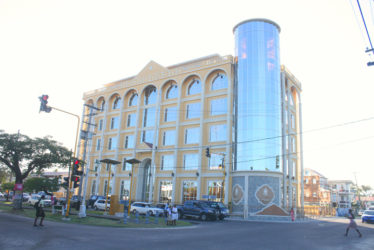Under the proposed lease agreement for rental of the building at the corner Camp and Lamaha streets, the University of Guyana (UG) would have to pay $6 million (plus VAT) per month for five years.
Stabroek News had previously reported that the rental sum was US$28,000 per month, however, it has since been able to confirm, through the owner of the building, Neal Sukhlal, as well as a copy of the lease that the sum is $6 million.

The proposed agreement, seen by Stabroek News, commits the university to the monthly rental fee plus all costs associated with keeping the building in good repair, in a clean, safe, wholesome, insurable and tenantable condition and in conformity with the requirements of the Mayor and City Council and all other applicable public authorities.
The building was among those being scouted for a downtown campus for UG. In November last year, UG’s Director of the Office of Strategic Initiatives Dr Fitzgerald Yaw told Stabroek News, “The selected UG downtown building [campus], after our due diligence, is expected to house a number of entities and offices, some of which are projected to be revenue generators.”
He had stressed that while the university will ultimately have to build its own downtown campus, it needed to rent while land and construction matters were worked out. As a result, he said that the Camp and Lamaha streets building was being explored for rental, but first a financial viability evaluation would be conducted before the university decided on tenancy.
Yaw was quick to point out that whatever building was rented has to bring in substantial revenue for the university and it will have to be up to the University Council and Finance and General Purposes Commit-tee to decide on the way forward.
The council has since rejected the proposal though Vice Chancellor Ivelaw Griffith is reportedly still keen to pursue the rental. Attempts by Stabroek News to reach Griffith for comment on the project and its proposed financial benefits proved futile as calls to his phone went unanswered.
The council has argued that taking on the responsibilities of renting a building for $6 million per month was nonsensical. One council member told this newspaper that it “does not seem the sensible thing to do at this time” and that before looking to rent a building where only about 60 students could be facilitated, it would be better to “invest in a structure of its own with that same money.”
Griffith had floated the building as a means of earning revenue for the university, telling the council that the Public Health Ministry as well as a premier international bank would be willing to sublet three floors while UG would utilize two floors to accommodate its Research and Innovative Fund’s Office and planned Philanthropy, Alumni and Civic Engagement office.
This newspaper understands that in a bid to promote the position to rent, a document was circulated to the members of the council by the Vice Chancellor and it gave a breakdown of plans and overheads for renting the building.
In November, Yaw had informed this newspaper that the revenue generators for the central Georgetown site will be a conference room that can be rented out to the public for functions, a business and graduate school, named the School of Entrepreneurship and Business Innovation (SEBI), and a business development unit.
The Camp and Lamaha streets building has been mostly unoccupied since its completion in 2013.
Last October, Sukhlal had told Stabroek News that interest had been expressed by a company via the Guyana Office for Investment (GO-Invest) and that construction modifications were being made to suit the potential lessee.
In June 2015, advertisements had been placed seeking potential tenants, pointing out that the 40,000 sq feet building was ideal for embassies, call centres, corporate offices among other entities. The advertisements had stated that the building has an elevator, central air-conditioning unit, and conference room, generator with an ATS system and a pressure pump with a water filtration system.
The building has evoked much interest because of its modern architecture and distinctive atrium. Sukhlal, who also owns and runs the Impressions advertising company, has remained in the background of what is a large investment and has never made public the cost of the building.









